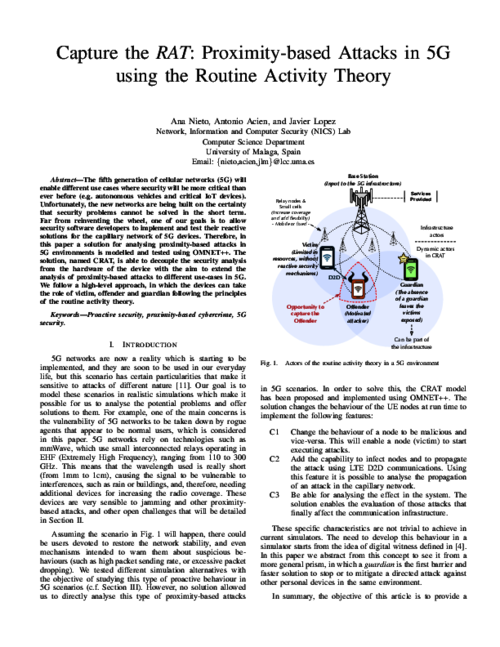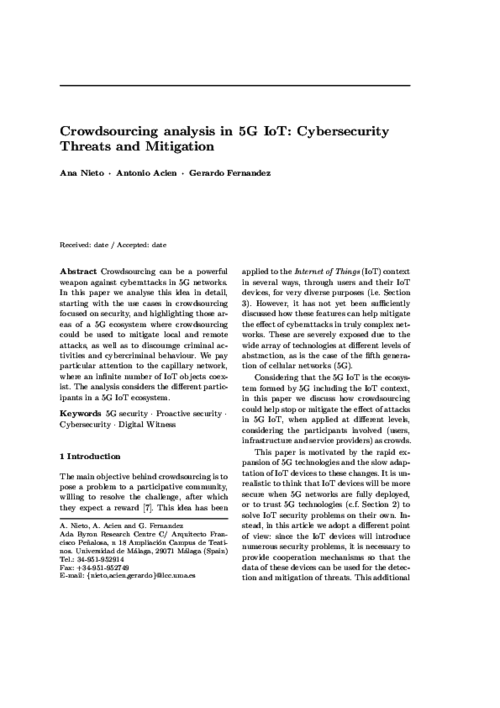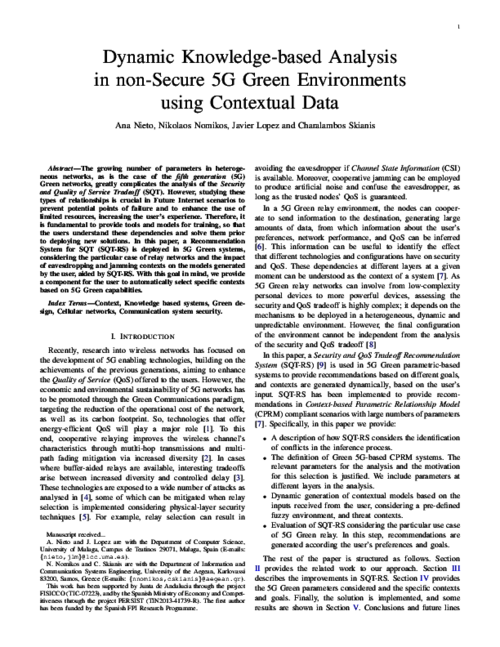 ] Title Type Year
] Title Type Year Telecommunication Systems , vol. 59, issue 1, Springer US, pp. 169-187, 05/2015. DOI
Abstract
In this article, we present relay selection policies in applications with secrecy requirements which are of interest in the fifth generation (5G) of wireless networks. More specifically, we provide a classification of relays based on their distinct communication attributes, such as processing, multiple antennas, storage, channel estimation, density and security level. In addition, we discuss the level of efficiency exhibited by each relay class, regarding their impact in delay-critical applications and green communications applications, while aiming at a specific security level at the physical layer. Then, relay selection policies are proposed taking into consideration the goals set by each application. Numerical evaluation of the proposed policies in terms of the average secrecy rate, average delay and power reduction show improved performance compared to other state-of-the-art solutions.
The 16th IEEE International Conference on Dependable, Autonomic and Secure Computing (DASC 2018), IEEE, pp. 520-527, 08/2018. DOI
Abstract
The fifth generation of cellular networks (5G) will enable different use cases where security will be more critical than ever before (e.g. autonomous vehicles and critical IoT devices). Unfortunately, the new networks are being built on the certainty that security problems can not be solved in the short term. Far from reinventing the wheel, one of our goals is to allow security software developers to implement and test their reactive solutions for the capillary network of 5G devices. Therefore, in this paper a solution for analysing proximity-based attacks in 5G environments is modelled and tested using OMNET++. The solution, named CRAT, is able to decouple the security analysis from the hardware of the device with the aim to extend the analysis of proximity-based attacks to different use-cases in 5G. We follow a high-level approach, in which the devices can take the role of victim, offender and guardian following the principles of the routine activity theory.

Mobile Networks and Applications (MONET), Springer US, pp. 881-889, 10/2018. DOI
Abstract
Crowdsourcing can be a powerful weapon against cyberattacks in 5G networks. In this paper we analyse this idea in detail, starting from the use cases in crowdsourcing focused on security, and highlighting those areas of a 5G ecosystem where crowdsourcing could be used to mitigate local and remote attacks, as well as to discourage criminal activities and cybercriminal behaviour. We pay particular attention to the capillary network, where an infinite number of IoT objects coexist. The analysis is made considering the different participants in a 5G IoT ecosystem.

IEEE Systems Journal, vol. 11, issue 4, no. 99, IEEE, pp. 2479-2489, 12/2017. DOI
Abstract
The growing number of parameters in heteroge- neous networks, as is the case of the fifth generation (5G) Green networks, greatly complicates the analysis of the Security and Quality of Service Tradeoff (SQT). However, studying these types of relationships is crucial in Future Internet scenarios to prevent potential points of failure and to enhance the use of limited resources, increasing the user’s experience. Therefore, it is fundamental to provide tools and models for training, so that the users understand these dependencies and solve them prior to deploying new solutions. In this paper, a Recommendation System for SQT (SQT-RS) is deployed in 5G Green systems, considering the particular case of relay networks and the impact of eavesdropping and jamming contexts on the models generated by the user, aided by SQT-RS. With this goal in mind, we provide a component for the user to automatically select specific contexts based on 5G Green capabilities.
